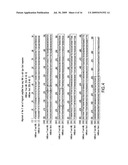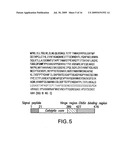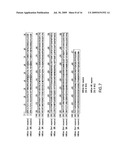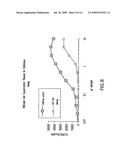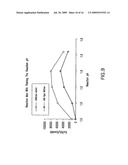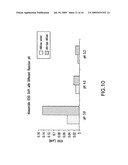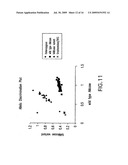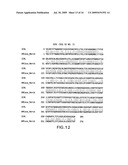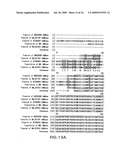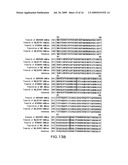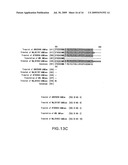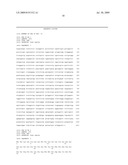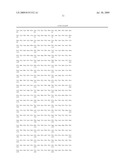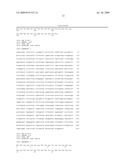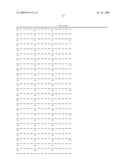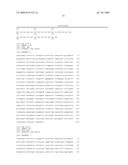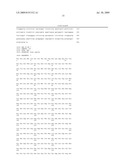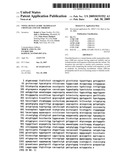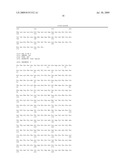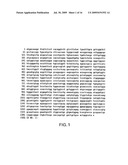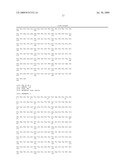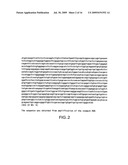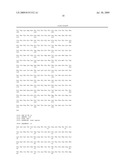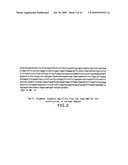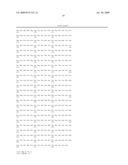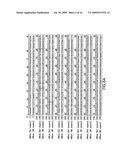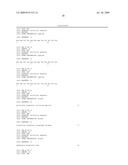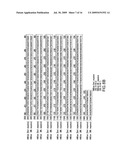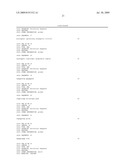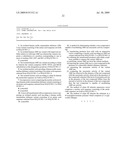Patent application title: Novel Human Acidic Mammalian Chitinase and Use Thereof
Inventors:
Kalpit A. Vora (Yardley, PA, US)
Julie A. Demartino (Westfield, NJ, US)
John Stuart Mudgett (Basking Ridge, NJ, US)
Gene Porter (Neptune, NJ, US)
Gloria Wolfe (New York, NY, US)
IPC8 Class: AC12Q168FI
USPC Class:
435 6
Class name: Chemistry: molecular biology and microbiology measuring or testing process involving enzymes or micro-organisms; composition or test strip therefore; processes of forming such composition or test strip involving nucleic acid
Publication date: 2009-07-30
Patent application number: 20090191552
Claims:
1. An isolated human acidic mammalian chitinase (AMCase) variant
consisting of the amino acid sequence set forth in SEQ ID NO: 2.
2. An isolated human AMCase variant with improved stability relative to wild-type AMCase wherein the variant comprises a substitution at a position corresponding to one or more of residues N45, D47, and R61 of SEQ ID NO: 4.
3. (canceled)
4. The isolated human AMCase variant according to claim 2, wherein the variant comprises D45N, N47D, and M61R substitutions at the designation positions of SEQ ID NO: 4.
5. An isolated nucleic acid encoding a human acidic mammalian chitinase variant consisting of an amino acid sequence selected from SEQ ID NO: 2 or SEQ ID NO: 4.
6. The isolated nucleic acid according to claim 4 wherein the nucleotide sequence set forth in SEQ ID NO: 1.
7. An expression vector comprising the nucleic acid encoding a human acidic mammalian chitinase variant consisting of an amino acid sequence selected from SEQ ID NO: 2 or SEQ ID NO: 4.
8. (canceled)
9. (canceled)
10. A host cell transformed with an expression vector comprising an isolated nucleic acid encoding a human acidic mammalian chitinase variant consisting of an amino acid sequence selected from SEQ ID NO: 2 or SEQ ID NO: 4.
11. (canceled)
12. A method for determining whether a test compound is capable of modulating AMCase enzymatic activity comprising:(a) transfecting producer host cells with an expression vector comprising a nucleic acid encoding an AMCase variant selected from SEQ ID NO: 2 or SEQ ID NO: 4;(b) culturing the transformed producer cells under conditions suitable to express the variant AMCase;(c) purifying variant AMCase from the culture medium;(d) exposing the variant AMCase to a test compound in the presence of a detectably labeled chitinase substrate;(e) measuring the enzymatic activity of the variant AMCase;(f) comparing the enzymatic activity of the variant AMCase observed in the absence of the test compound with the enzymatic activity observed in the presence of the compound; wherein if the level of enzymatic activity in the presence of the test compound differs from the amount of activity in the absence of the test compound, then the test compound is capable of modulating AMCase activity.
13. The method of claim 12 wherein expression vector comprises a nucleic acid sequence consisting of the nucleotide sequence set forth in SEQ ID NO: 1.
14. The method of claim 12 wherein the substrate in a N-acetylglucoseamine polymer which comprises β 1,4 glycosidic linkages.
Description:
FIELD OF THE INVENTION
[0001]The present invention relates to a variant human acidic mammalian chitinase (AMCase) having improved stability and an isolated nucleic acid sequence which encodes the variant. The invention also relates to nucleic acid constructs, vectors, and host cells comprising the nucleic acid sequences. The invention further provides methods for producing the variant AMCase polypeptide and methods of using the variant enzyme to screen for AMCase modulators.
BACKGROUND OF THE INVENTION
[0002]Chitin, a polymer of N-acetylglucosamine, is the second most abundant polysaccharide in nature. It is widely expressed as a surface component of the exoskeletons of many arthropods, of fungal cell walls, and of the microfilarial sheaths of parasitic nematodes. Generally speaking, chitin protects pathogens from harsh environmental conditions and host-mediated responses.
[0003]Chitinases (i.e., endo-β-3-1,4-acetylglucosanidases) are ubiquitous enzymes which cleave (hydrolyze) chitin. The innate immune response of many lower life forms, including plants, insects, and fish, to an infection by a chitin-containing pathogen includes chitinase induction. Family 18 chitinases define as group of enzyme which share a conserved catalytic site motif. Family 18 members hydrolyse β 1,4 linkages containing glutamic acid as a key catalytic site residue and proton donor.
[0004]Because chitin does not have a mammalian counterpart, it was generally assumed that mammals lack chitinolytic enzymes, and that the chitinase genes found in the human genome merely represent relics of evolution. However, recent studies have identified chitinase and chitinase-like enzymes in both rodents and human subjects. The lack of endogenous mammalian chitin suggests that other, unidentified endogenous substrates, or other enzymatic activities remain to be characterized.
[0005]Acidic mammalian chitinases (AMCases) represent a unique subset of mammalian enzymes because they hydrolyze chitin and chitin-like substrates with an acidic pH optimum. AMCase is known to be predominantly expressed in the gastrointestinal tract and stomach where it is thought to play a role as antiparasitic defense mechanism. It may also play a role in the normal digestive process. AMCase is expressed to a lesser extent in the lung. During acute asthmatic attacks exhaled airway vapor condensates are known to be acidified, and the upregulation of AMCase expression observed in murine models of asthma suggests that chitinases are involved in allergic immune responses. However, there remains a need to understand the role of chitinases the pathogenesis of asthma, and to establish screening assays capable of identifying potential therapeutics which are capable of modulating molecular targets implicated in mammalian disease processes.
SUMMARY OF THE INVENTION
[0006]The present invention relates to a novel human acidic mammalian chitinase (hAMCase) isoform (allelic variant) and a nucleic acid molecule (a cDNA) encoding the variant enzyme. The disclosed allelic variant differs by three amino acids from the reference sequence published in GenBank as AF 290004 (wild-type human AMCase) (SEQ ID NO: 4) (also referred to herein as the Boot Sequence) (J. Biol. Chem. 276(9):6670-6678 (2001). The three amino acid substitutions present in the disclosed variant of hAMCase appear to lend stability to the recombinantly expressed protein, which in turn allows for more efficient production of active enzyme. Therefore, the variant facilitates the development and use of high through put screening assays designed to identify and study modulators of the enzyme's activity. The knowledge that AMCase expression/activity is associated with inducing the symptoms and/or complications of asthma renders AMCase sequences useful in methods for identifying agents which are capable of modulating AMCase activity and which therefore represent potential therapeutic agents.
[0007]One aspect of the present invention provides an isolated human acidic mammalian chitinase (AMCase) variant (or isoform) consisting of the amino acid sequence set forth in SEQ ID NO: 2. Importantly, the disclosed human AMCase variant has improved stability relative to wild-type human AMCase. In one embodiment of this aspect of the invention the disclosed AMCase variant comprises a substitution at a position corresponding to one or more of residues N45, D47, and R61 SEQ ID NO: 4, which sets forth the reference amino acid sequence of what is referred to herein as wild-type AMCase. In an alternative embodiment the invention provides a human AMCase variant with improved stability relative to wild-type AMCase wherein the variant comprises substitutions at all three positions corresponding to N45, D47, and R61, as exemplified by the amino acid sequence set forth in SEQ ID NO: 2 which comprises three substitutions (D45N, N47D, and M61R) substitutions relative to the amino acid sequence of the reference AMCase protein.
[0008]A second aspect of the invention provides a nucleic acid molecule which encodes either the full-length variant enzyme or a fragment of the disclosed AMCase variant. One embodiment of this aspect of the invention is provided by SEQ ID NO: 1, which provides a cDNA which encodes the full-length variant AMCase. One of skill in the art will readily acknowledge that due to degeneracy of the genetic code, alternative nucleic sequences capable of coding for the amino acid sequence set forth in SEQ ID NO: 2 can be utilized to express the variant isoforms in suitable transformants. Accordingly, the scope of the invention includes all nucleic acid molecules which include alternative nucleotide sequences which encode the disclosed variant enzyme.
[0009]Other aspects of the invention provide expression vectors comprising nucleic acids which encode the variant AMCase, and host cells transformed with the expression vectors of the invention. The transformed host cells disclosed herein can be used in the context of a method suitable for the production of the disclosed variant AMCase enzyme, which can be subsequently purified from tissue culture media and used to establish an enzymatic activity assay designed to identify and characterized compounds that are capable of modulating AMCase's enzymatic activity.
[0010]For example, the disclosed AMCase variant can be employed in a high throughput screening assay to determine whether a test compound is capable of modulating the enzymatic (e.g. chitinolytic) activity or level of AMCase. Accordingly, the sequences, vectors and host cells of the invention can be used in a method which is based on the following steps: 1) transfecting producer host cells with an expression vector comprising a nucleic acid encoding a variant AMCase wherein the variant consists of the amino acid sequence set forth in SEQ IN NO: 2; 2) culturing the transformed producer cells under conditions suitable to express the variant AMCase; 3) purifying variant AMCase from the culture medium; 4) exposing the variant AMCase to a test compound in the presence of a detectably chitinase substrate; 5) measuring the chitinolytic activity of the variant AMcase; and 6) comparing the chitinolytic activity of the variant AMcase observed in the absence of the test compound with the chitinolytic activity observed in the presence of the compound; wherein if the level of chitinolytic activity in the presence of the test compound differs from the amount of activity in the absence of the test compound, then the test compound is capable of modulating AMCase activity.
[0011]Other embodiments, features and advantages of the present invention will become apparent from the following detailed description. It should be understood, however, that the detailed description and specific examples, while indicating preferred embodiments of the invention, are given by way of illustration only, since various changes and modifications within the scope and spirit of the invention will become apparent to one skilled in the art from this detailed description. The examples provided in this disclosure are not intended to limit the scope of the claimed invention.
BRIEF DESCRIPTION OF THE DRAWINGS
[0012]FIG. 1 provides the nucleotide sequence (SEQ ID NO: 1) of a cDNA which encodes the AMCase allelic variant of the invention.
[0013]FIG. 2 provides the nucleotide sequence of a 1229 base pair nucleic acid cloned from human stomach DNA (SEQ ID NO: 5) (referred to as "hAMCase (stom) 5' end).
[0014]FIG. 3 provides the nucleotide sequence of a 561 base pair fragment cloned from human total lung RNA (SEQ ID NO: 6. The bolded and italicized nucleotides are different from the nucleotides reported in the wild type Boot sequence.
[0015]FIG. 4 provides an alignment of SEQ ID NO: 6 (hAMCase 5' end MRL) with the 5' end of wild-type human AMCase (SEQ ID NO: 3) (the Boot sequence).
[0016]FIG. 5 provides the amino acid sequence (SEQ ID NO: 2) of the human AMCase (hAMCase) variant encoded by SEQ ID NO: 1, and a graphic representation of the location of various protein domains.
[0017]FIGS. 6A and 6B provide an alignment comparing the nucleotide sequence of SEQ ID NO: 1 cDNA for variant hAMCase (MRL sequence) with the nucleotide sequence of the wild-type AMCase coding sequence of GenBank Accession AF 290004 (SEQ ID NO: 3).
[0018]FIG. 7 provides an alignment comparing the amino acid sequence of SEQ ID NO: 2 (h-AMCase) (MRL sequence) with the amino acid sequence (SEQ ID NO: 4) (Boot sequence) of the wild-type AMCase product of SEQ ID NO: 3.
[0019]FIG. 8 is a graphic representation comparing the enzymatic activity of the hAMCase variant of the invention compared with the enzymatic activity of the wild-type AMCase (Boot AMCase).
[0020]FIG. 9 provides a graphic representation of the pH profile and reaction max of the variant and wild-type AMCases.
[0021]FIG. 10 provides a graphic representation of the effect of pH on the Allosamidin IC50 value of the variant and wild-type AMCases.
[0022]FIG. 11 provides an alleleic discrimination plot resulting from a single nucleotide polymorphism (SNP) assay.
[0023]FIG. 12 provides the Smith-Waterman sequence alignment data for hAMCase and its most homologous protein Ym1 (SEQ ID NO: 7) (PDB code: 1E9L).
[0024]FIGS. 13A and 13B provide an alignment comparing the amino acid sequences of Elias (NM--021797) (SEQ ID NO: 8), Saito (AB025008) (SEQ ID NO: 9), Boot (AF290004) (SEQ ID NO: 4), the MRL AMCase variant (SEQ ID NO: 2), and the translation of NM201653 (SEQ ID NO: 10) which represents a hAMCase consensus sequence.
DETAILED DESCRIPTION OF THE INVENTION
[0025]The patent and scientific literature referred to in this disclosure is cited to establish knowledge that is available to those of skill in the art. The citations referred to herein, including issued U.S. patents, published patent applications (U.S. and foreign), references including GenBank database sequences, cited herein are incorporated by reference to the same extent as if each was individually and specifically incorporated by reference. The references cited throughout the present disclosure are not admitted to be prior art to the claimed invention.
[0026]Unless defined otherwise, technical and scientific terms used herein have the meanings commonly understood by one of ordinary skill in the art to which the present invention pertains. One skilled in the art will recognize other methods and materials similar or equivalent to those described herein, which can be used in the practice of the present teaching. It is to be understood, that the teachings presented herein are not intended to limit the methodology or processes described herein. For purposes of the present invention, the following terms are defined below.
[0027]"Chitinase," as used herein, refers to a family of polypeptides comprising mammalian chitinases. A chitinase of the present invention demonstrates detectable chitinase activity, in that it specifically cleaves chitin in an endochitinase manner.
[0028]An "AMCase modulator," as the term is used herein, includes a molecule compound (or agent), that modulates the enzymatic activity of AMCase. Such modulators includes, but are not limited to, small molecules and chemical compounds that increase or inhibit the level of AMCase activity in a cell or tissue compared with the level of AMCase activity in the cell or tissue in the absence of the modulator, or in an otherwise identical cell or tissue, in the absence of the modulator. Agents which decrease the enzymatic activity of AMCase represent a subset of modulators which represent potential therapeutic agents because of their ability to inhibit AMCase.
[0029]The term "polypeptide" or "protein" as used herein refers to a compound made up of a single chain of amino acid residues linked by peptide bonds.
[0030]As used herein the term "nucleic acid" or "nucleic acid molecule" includes RNA, DNA, and cDNA molecules. It will be understood that, as a result of the degeneracy of the genetic code, a multitude of nucleotide sequences encoding a given protein such as AMCase may be produced. The present invention contemplates every possible variant nucleotide sequence, encoding AMCase, all of which are possible given the degeneracy of the genetic code.
[0031]As used herein, the term "gene" means the segment of DNA involved in producing a polypeptide chain, that may or may not include regions preceding and following the coding region, e.g. 5' untranslated (5' UTR) or "leader" sequences and 3' UTR or "trailer" sequences, as well as intervening sequences (introns) between individual coding segments (exons).
[0032]As used herein, the term "vector" refers to a nucleic acid construct designed for transfer between different host cells. An "expression vector" refers to a vector that has the ability to incorporate and express heterologous DNA fragments in a foreign cell. Many prokaryotic and eukaryotic expression vectors are commercially available. Selection of appropriate expression vectors is within the knowledge
[0033]As used herein an "expression cassette" or "expression vector" is a nucleic acid construct generated recombinantly or synthetically, with a series of specified nucleic acid elements that permit transcription of a particular nucleic acid in a target cell. The recombinant expression cassette can be incorporated into a plasmid, chromosome, mitochondrial DNA, plastid DNA, virus, or nucleic acid fragment. Typically, the recombinant expression cassette portion of an expression vector includes, among other sequences, a nucleic acid sequence to be transcribed and a promoter.
[0034]As used herein, the term "plasmid" refers to a circular double-stranded (ds) DNA construct used as a cloning vector, and which forms an extrachromosomal self-replicating genetic element in many bacteria and some eukaryotes.
[0035]As used herein, the term "promoter" refers to a nucleic acid sequence that functions to direct transcription of a downstream gene. The promoter will generally be appropriate to the host cell in which the target gene is being expressed. The promoter together with other transcriptional and translational regulatory nucleic acid sequences (also termed "control sequences") is necessary to express a given gene. In general, the transcriptional and translational regulatory sequences include, but are not limited to, promoter sequences, ribosomal binding sites, transcriptional start and stop sequences, translational start and stop sequences, and enhancer or activator sequences.
[0036]As used herein, the term "selectable marker-encoding nucleotide sequence" refers to a nucleotide sequence which is capable of expression in cells and where expression of the selectable marker confers to cells containing the expressed gene the ability to grow in the presence of a corresponding selective agent, or under corresponding selective growth conditions.
[0037]A nucleic acid is "operably linked" when it is placed into a functional relationship with another nucleic acid sequence. For example, DNA encoding a secretory leader is operably linked to DNA for a polypeptide if it is expressed as a preprotein that participates in the secretion of the polypeptide; a promoter or enhancer is operably linked to a coding sequence if it affects the transcription of the sequence; or a ribosome binding site is operably linked to a coding sequence if it is positioned so as to facilitate translation. Generally, "operably linked" means that the DNA sequences being linked are contiguous, and, in the case of a secretory leader, contiguous and in reading frame. However, enhancers do not have to be contiguous. Linking is accomplished by ligation at convenient restriction sites. If such sites do not exist, the synthetic oligonucleotide adaptors, linkers or primers for PCR are used in accordance with conventional practice.
[0038]The term "introduced" in the context of inserting a nucleic acid sequence into a cell, means "transfection" or "transformation" or "transduction" and includes reference to the incorporation of a nucleic acid sequence into a eukaryotic or prokaryotic cell where the nucleic acid sequence may be incorporated into the genome of the cell (for example, chromosome, plasmid, plastid, or mitochondrial DNA), converted into an autonomous replicon, or transiently expressed (for example, transfected mRNA).
[0039]By the term "host cell" is meant a cell that contains a vector and supports the replication, and/or transcription or transcription and translation (expression) of the expression construct. Host cells for use in the present invention can be prokaryotic cells, such as E. coli, or eukaryotic cells such as yeast, plant, insect, amphibian, or mammalian cells. In general, host cells are filamentous fungi.
[0040]As used herein, the term "expression" refers to the process by which a polypeptide is produced based on the nucleic acid sequence of a gene. The process includes both transcription and translation.
[0041]As used herein, the terms "active" and "biologically active" refer to a biological activity associated with a particular protein and are used interchangeably herein. For example, the enzymatic activity associated with a chitinase is hydrolysis and, thus, an active chitinase has hydrolytic activity. It follows that the biological activity of a given protein refers to any biological activity typically attributed to that protein by those of skill in the art.
[0042]As used herein the term "variant" generally means a protein that is related to a parental protein (e.g., the wild-type protein) by addition of one or more amino acids to either or both the C- and N-terminal end, substitution of one or more amino acids at one or a number of different sites in the amino acid sequence, or deletion of one or more amino acids at either or both ends of the protein or at one or more sites in the amino acid sequence. As used herein, "variants", includes polynucleotides or polypeptides containing one or more deletions, insertions or substitutions, as long as the variant retains substantially the same activity of the wild-type polynucleotide or polypeptide. With regard to polypeptides, deletion variants are contemplated to include fragments lacking portions of the polypeptide not essential for biological activity. Substitution variants include polypeptides consisting of one or more nucleic acids which differ from the nucleic acid which occupies the corresponding residue position in the wild-type AMCase polypeptide.
[0043]The term "variant acidic mammalian chitinase gene" or "variant AMCase" means, respectively, that the nucleic acid sequence of the AMCase reference gene has been altered by removing, adding, and/or manipulating the coding sequence of the gene, or that the amino acid sequence of the expressed protein has been modified consistent with the invention described herein.
[0044]As used herein the term "allosamidin" refers to a pseudo-trisaccharide with the chemical name (3aR,4R,5R,6S,6aS)-2-(dimethylamino)-3a,5,6,6a-tetrahydro-4-hydroxy-6-(hy- droxymethyl)-4H-cyclopentoxazol-5-yl 2-(acetylamino)-4-O-[2-(acetylamino)-2-deoxy-β-D-allopyranosyl]-2-de- oxy-β-D-allopyranoside and formula C25H42N.sub.4O14 which is a pan-family 18 chitinase inhibitor.
[0045]As used herein the term "stability" refers the ability to retain enzymatic activity during the purification process and/or to the observation of no loss of enzymatic activity upon repeated freeze thawing cycles.
[0046]As used herein "improved production" refers to increased yield of enzyme obtained from transfected supernatants of host cells (e.g., HEK293 cells) transfected with similar amounts of DNA.
[0047]The mammalian chitinase field has been hampered by an inability, using constructs encoding the published cDNA sequence of human AMCase (hAMCase), to express sufficient recombinant enzyme for characterization, structural studies or HTS development. This invention details the identification of a novel, naturally occurring isoform/allelic variant of hAMCase which differs in sequence by three amino acids from the reference sequence published as GenBank AF 290004 (SEQ ID NO: 4). As shown herein the three amino acid substitutions present in the disclosed variant of hAMCase confers stability to the recombinantly expressed protein, which in turn has the effect of allowing for more efficient production of active enzyme. Moreover, the much greater quantities of recombinant active enzyme produced by host cells expressing the variant sequence makes structural studies of enzyme/inhibitor complexes more feasible which in turn may expedite, through rationale drug design, the identification of chitinase inhibitors characterized by enhanced potency and selectivity.
[0048]Chitin is a glycopolymer of B(1-4 linked N-acetyl-D-glucosamine units. Chitin may also contain glucosamine units in different proportions. The chain length of N-acetylglucosamine polymers have been reported to range from 100 to approximately 8000 units. Typically, the polymers assemble laterally to form microfibrils, stabilized by strong hydrogen bonds between the amine group of sugar in one chain and the carbonyl group of sugar in an adjoining chain. To date, three crystallographic forms of chitin have been reported.
[0049]Chitonases are widespread in nature, and all chitin-containing organisms are presumed to require enzyme systems that allow them to degrade chitin polymers as a prerequisite for morphogenesis (i.e., essential modification of their shape). Several enzymatic activities can be distinguished: 1) B-hexosaminidases that are capable of removing the terminal N-acetylglucosamine moiety from the non-reducing end of the polysaccharide; 2) lysozymes with a broad specificity, such as egg white lysozyme, are capable of leaving the chitin glycopolymer; 3) exochitinases which cleave diacetylchiobiose units from the nonreducing end of the polysaccharide; and 4) specific endochitinases which cleave glycoside linkages randomly along the chitin chain, thereby giving rise to diacetylchitobiose as a major product together with some triacetylchitotriose. Typically, the term chitinase is used to refer to enzymes with either an exo- and endochitinase activity. As used herein, the term chitinase refers to a family of polypeptides which specifically cleave chitin in an endochitinase manner.
[0050]Chitinases constitute families 18 and 19 of the glycosylhydrolases. Recent data suggesting that AMCase and other Family 18 chitonases play a key role in the pathophysiology of inflammatory disorders, including lung inflammation and asthma support the assertion that Family 18 chitonases represent validated drug targets. Family classifications are based on amino acid sequence similarity. The typical structure of a chitinase consists of a signal peptide, a glycohydrolase domain and a chitin-binding domain. AMCase contain a N-terminal catalytic core domain, and a C-terminal chitin binding domain separated by a hinge region (see FIG. 5). Thus far, one or more of these characteristic features can be found in all of the identified and characterized mammalian chitinases. There is considerable homology in the putative active site regions of Family 18 members and the reaction mechanism is believed to be general acid-base catalysis.
[0051]The catalytic domain of family 18 chitinases has a (αβ)8 (TIM barrel) fold with conserved DXDXE (SEQ ID NO: 23) catalytic motif that spans strand 4 of the TIM barrel and includes the glutamate that acts as the catalytic acid. However, many family members have been found lacking chitinolytic activity because of mutations in the highly conserved catalytic domain of these proteins. The amino acid sequence of AMCase includes this conserved region (133-FDGLDFDWEYPG-143) (SEQ ID NO: 11) as reported for many chitinases that show catalytic activity. When the catalytic site was mutated by replacing 2 amino acids using point mutations in murine chitotriosidase (FDGLNLDWQFPG) (SEQ ID NO: 12) the recombinant protein was no longer active. Chilectins like YKL-40 lack the active site glutamic acid (FDGLDLAWLYPG) (SEQ ID NO: 13) which is replaced by glutamine and hence lack enzyme activity. The active site grooves of these chitinases are lined with aromatic amino acids that contribute to polysaccharide substrate binding.
[0052]AMCase has been implicated as a potential drug target for airway disease like asthma/COPD and inflammatory diseases of the GI tract including IBD/Crohns. Therefore, the invention provides a novel allelic variant of acidic mammalian chitinase (AMCase) and its DNA, which is useful as a druggable target for the development of compounds capable of inhibiting the pathophysiological processes implicated in airway disease like asthma/COPD and inflammatory diseases of the GI tract including IBD/Crohns.
[0053]AMCase has been reported to be highly expressed in the lungs of mice sensitized to ovalablumin, and it has been implicated as playing a role in the pathophysiology of bronchial asthma in murine models. A gene expression study published by Zimmermann et al. has observed that AMCase expression is directly correlated with an asthmatic phenotype (Zimmermann et al., J. Immunol. 172:1815-1824 (2004). Inhibition of AMCase has been reported to lead to abrogated T-helper cell type 2-mediated inflammation, to reduce bronchial hyperactivity, and to lower eosinophil counts. In humans, AMCase has been observed to be highly expressed in the lungs of asthmatic patients, but not in the lungs of healthy individuals (Zhu, Z., et al. Science 304:1678-1682 (2004). In addition, the recent description of a polymorphism in AMCase that is associated with lower bronchodilator responsivemess in Puerto Rican asthmatics further supports the position that AMCase plays a role in the pathogenesis of asthma (Siebold, M. A., et al., Proc. Am. Thor. Soc., 2:A79 (2005).
[0054]Using the sequences provided herein, a skilled artisan can utilize well-known methods to produce and purify the variant enzyme for use in a HTS assay to identify AMCase modulators. The expressed protein can be purified from the supernatants or from cell lysates using standard protein purification protocols. A skilled artisan will readily acknowledge that an AMCase polypeptide can be purified by chromatographic, electrophoretic or centrifugation techniques. A representative, non-limiting purification protocol is described in the examples at the end of this disclosure.
[0055]A nucleotide sequence encoding a human AMCase polypeptide (e.g., a cDNA) having the amino acid sequence of the disclosed variant may be inserted in an expression vector for subsequent protein production by a suitable host cell. Any of a number of expression vectors could by used to produce the variant, including plasmid or viral vectors. For example, retroviral, adenoviral, or adeno-associated viral vectors could be used. Typically, a recombinant expression vector includes other known genetic elements (e.g., regulatory elements), that are either desirable or necessary to direct the efficient expression of the nucleic acid in a specific host cell, operatively linked to a coding sequence.
[0056]At a minimum expression vectors typically comprise a promoter and any necessary enhancer sequences to achieve transcription of the coding sequence. As used herein, a nucleotide sequence is "operatively linked" to another nucleotide sequence when it is placed in a functional relationship with the other sequence. In the case of a promoter element and a coding sequence this typically means that the DNA sequences are contiguous such that the promoter can function to initiate transcription of the coding sequence.
[0057]Expression vectors may optionally include a reporter gene operably linked to the promoter element. Suitable genes may encode, for example, luciferase, B-galactosidase, chloramphenical acetyltransferase, B-glucoronidase, alkaline phosphatase, green fluorescent protein, or other reporter gene products known to the art.
[0058]For example, an AMCase polypeptide can be expressed by cloning a nucleotide sequence encoding a polypeptide consisting of the variant AMCase amino acid sequence set forth in SEQ ID NO: 2 into the multiple cloning region of the expression vector p3Xflag-CMV13 (sigma-E4776) or any other eukaryotic expression vectors not limited to (pcDNA, pCImamalian expression vector, pIRES etc) available commercially or of propriety origin. Such a vector contains a leader sequence 5' of the multiple cloning sequences to facilitate excretion of the translated protein into the media. The vector also contains 3 adjacent tagged epitopes (e.g. Flag, His etc) downstream of the multiple cloning regions to encode a c-terminal tag peptide facilitating its purification. The vector also contains the selectable marker, aminoglycoside phosphotransferase II gene (neo) which confers resistance to G418 and allows for the production of stable transfectants. Transcription of each cDNA is driven by the promoter-regulatory region of the human cytomegalovirus or any other suitable promoter and followed by the polyadenylation/transcription termination signal of eukaryotic origin for example the human growth hormone gene (hGH PolyA).
[0059]Alternatively, separate constructs can also be constructed without the tag or cleavable tag which have cleavable sequence (like Factor Xa) added downstream of the respective cDNA and just upstream of the tag epitope. This will allow for the removal of the tag after translation and purification.
[0060]A wide variety of host cells can be used to produce the desired quantity of variant AMCase protein. Such cells include, but are not limited to, prokaryotic and eukaryotic cells, including bacterial or mammalian host cells well-known in the art. Exemplary host cells include, HRK293 A cells, Chinese hamster ovary cells (CHO), COS cells, yeast, or bacteria belonging to the genus E. coli or Bacillus.
[0061]Numerous methods are available to introduce an expression vector into a host cell, including mechanical methods, chemical methods, lipophilic methods or electroporation. Use of calcium phosphate or DEAE-Dextran are representative, non-limiting examples of available chemical methods of introducing an expression vector into a host cell. Use of gene gun and microinjection are examples of mechanical methods. Lipophilic methods include use of liposomes and other cationic agents for lipid-mediated transfection.
[0062]Production of a variant enzyme is typically achieved by preparing a DNA sequence which encodes the variant protein, constructing a suitable expression vector based on the host cell of choice, transforming the host cell according to a protocol that will result in transient or stable transfection, and culturing the transformant under suitable conditions to express and produce the recombinant enzyme. As shown herein the variant AMCase enzyme of the invention provides a polypeptide comprising altered amino acid sequences in comparison with the amino acid sequence of the wild-type enzyme and while the variant enzyme retains the characteristic chitinolytic nature of the reference enzyme it produces a more stable recombinant protein.
[0063]As shown herein, the disclosed nucleic and amino acid sequences of the AMCase variant can be used to establish a HTS assay designed to identify agents which are capable of modulating AMCases enzymatic activity. Because the endogenous human (or mammalian) substrate for AMCase has not yet been identified, in vitro enzymatic activity assays are typically performed with a chitin-like substrate such as chito-biose or triose linked to 4-methylubelliferyl beta-D-N,N',N''-triacetylchitotriose.
[0064]Numerous artificial chitinase substrates can be used to determine the chitinolytic activity of an AMCase or AMCase variant enzyme including, but not limited to: 4-methylubelliferyl beta-D-N,N',N''triacetylchitotriose, polymers of chitin or their derivatives, N.sup.I,N.sup.II,N.sup.III,NIV-Tetra-acetyl-NV-dimethylaminophenylaz- ophenyl-thioureido-β-chitopentaosyl-pyroglutamyl amidoethylnaphtalene sulfonic acid. Two substrates that have been used routinely for assay are 4-methylubelliferyl beta-D-N,N',N''-triacetylchitotriose, and 4-methylubelliferyl beta-D-N,N'-Diacetylchitobiose. Besides these polymers of chitin or their derivatives, NI, NII, NIII, NIV-Tetra-acetyl-NV-dimethylaminophenylazophenyl-thioureido-chitopentaosy- l-pyroglutamyl amidoethylnaphtalene sulfonic acid could be used to evaluate the enzymatic activity.
[0065]Any other substrate for chitinases that allows easy detection of enzymatic activity could be used including fluorescent substrates, colored dyes and turbid substrates that become clear upon subjected to chitinase activity. These may include colloidal chitin, glycol chitin, 3-4 dinitrophenyl tetra-N-acetyl chitotrioside. Any type of solid or liquid media that will support growth and reproduction of recombinant or natural chitinase secreting, bacteria, yeast or mammalian cell also amounts to measuring the enzyme activity.
[0066]In practice, a wide variety of in vitro assay formats using an isolated AMCase polypeptide can be used to determine whether a test agent modulates the activity of the human AMCase enzyme. For example, the amount of reactants remaining and/or products produced in reactions catalyzed by AMCase can be quantified. It is well-known that AMCase catalyzes the conversion of chitin to N-acetyl-D-glucosamine. A nonlimiting example of a suitable assay design would involve monitoring the conversion of chitin or a chitin-like compound to N-acetyl-D-glucosamine. The enzyme activity could also be monitored by estimating the amount of substrate left or the products formed. A non-limiting example of substrate being chitin or its derivatives and N-acetyl-D-glucosamine of the product formed due to chitinase activity. Additionally, the skilled artisan would appreciate, once armed with the teachings of the present invention, that inhibition of a chitinase enzyme includes inhibition of the chitinolytic activity in a cell.
[0067]Possible reactions which could be quantified include, without limitation, the release of 4-methylumbelliferyl β-D-N,N'-diacetylchitobiose or 4-methylumbelliferyl β-D-N,N''-triacetylchitotriose; or the release of p-nitrophenyl from p-nitrophenyl β-D-N,N',N''-triacetylchitotriose. In practice, the amount of chitin remaining after AMCase is contacted with the test agent as a function of time is determined. Similarly, the amount of N-acetyl-D-glucosamine or 4-methylumbelliferyl or p-nitrophenyl produced after the chitinase is contacted with the test agent, in the presence of chitin, as a function of time could also be monitored. A skilled artisan can easily identify various assays that can be used to quantify one of these products and/or reactants.
[0068]Methods of quantitating chitin are known to the art, including the use of various immunoassays, such as enzyme-linked immunoassays. Alternatively, a colorimetric assay can be used to determine the quantity of N-acetyl-D-glucosamine, as described in Reissig, J. L., J. Biol. Chem. 217:959-966 (1955). Well-known chromatographic methods, including high performance liquid chromatography can be employed to determine the amount of glucosamine. Fluorometric assays could be used to determine the amount of 4-methylumbelliferyl or p-nitrophenyl as described, for example in U.S. Pat. No. 5,561,051. Alternatively, fluorophore-assisted carbohydrate electrophoresis could also be used to monitor an AMCase catalyzed reaction.
[0069]One of skill in the art would readily appreciate, based on the disclosure provided herein, that a AMCase modulators include chemical compounds that inhibit the activity of a chitinase. Chitinase inhibitors are well known in the art, and some of the key critical elements of one class of chitinase-like molecule inhibitors have been defined (Spindler and Spindler-Barth, 1999, Chitin and Chitinases, Birkhauser Verlag Basel, Switzerland). Additionally, a chitinase-like molecule inhibitor encompasses a chemically modified compound, and derivatives, as is well known to one of skill in the chemical arts.
[0070]The skilled artisan would appreciate that AMCase inhibitors include well-known agents such as, but not limited to, allosamidin (Allosamidine, Carbohydrate Chemistry Industrial Research Limited, Lower Hutt, New Zealand, and Eli Lilly and Co., Greenfield, Ind.) and its derivatives (see, e.g., U.S. Pat. No. 5,413,991), glucoallosamidin A, glucoallosamidin B, methyl-N-demethylallosamidin (Nishimoto et al., 1991, J. Antibiotics 44:716-722) demethylallosamidin (U.S. Pat. No. 5,070,191), and didemthylallosamidin (Zhou et al., 1993, J. Antibiotics 46:1582-1588). Such agents provide the skilled artisan with a positive control which can be used to validate a HTS assay designed to identify AMCase modulators that are of potential therapeutic value because of their ability to inhibit AMCase. Alternatively, screening assays could also be validated using other known inhibitors of chitinase enzymatic activity, including, inter alia, allosamidin, 1,10-phenanthroline, glucoallosamidin A, glucoallosamidin B, methyl-N-demethylallosamidin, demethylallosamidin, didemthylallosamidin.
[0071]Further methods of identifying and producing potential AMCase are well known to those of ordinary skill in the art, including, but not limited, obtaining molecular agents from a naturally occurring source (i.e., Streptomyces sp., Pseudomonas sp., Stylotella aurantium). Alternatively, potential AMCase modulators can be synthesized chemically. Compositions and methods for chemically synthesizing potential modulators or for obtaining them from natural sources are well known in the art and are described in, among others, Yamada et al., U.S. Pat. Nos. 5,413,991, and 5,070,191.
[0072]Examples are provided to further illustrate different features of the present invention. The embodiments provided identify useful reagents and methodologies that are useful for practicing the invention. These examples do not limit the claimed invention.
[0073]Any suitable materials and/or methods known to those of skill can be utilized in carrying out the present invention; however, preferred materials and/or methods are described. Materials, reagents and the like to which reference is made in the following examples are obtainable from commercial sources, unless otherwise noted.
[0074]Techniques for recombinant gene production, introduction into a cell, and recombinant gene expression are well known in the art. Examples of such techniques are provided in references such as Ausubel, Current Protocols in Molecular Biology, John Wiley, 1987-2002, and Sambrook et al., Molecular Cloning, A Laboratory Manual, 2nd Edition, Cold Spring Harbor Laboratory Press, 1989.
EXAMPLES
Example 1
Cloning hAMCase Variant cDNA
[0075]Cloning of Partial Human AMCase Variant cDNA from Stomach
[0076]Human AMCase cDNA was cloned by PCR amplification of Poly A+ RNA from using Quick-Clone cDNA (BD Biosciences. Cat. # 7126-1). The source of the Poly A+ RNA was normal stomachs pooled from 10 male/female Caucasians, ages 25-53 and the cause of death was trauma. We used the following PCR primers: ACMF primer 5'-gccaccatgacaaagcttattctcctcacaggtcttg-3' (SEQ ID NO: 14) and ACMR primer 5'-ttatgcccagttgcagcaatcacagotggtgtcgaag (SEQ ID NO: 15). The primers were made according to the published sequence for wild-type AMCase (SEQ ID NO: 3) (accession number AF 290004).
[0077]Two PCR amplification reactions were performed with Pfiu Turbo® DNA Polymerase (Stratagene Cat #600153) under the following conditions: 95 C for 2 minutes, and 30 cycles of 95° C. for 45 seconds, 55° C. for 45 seconds and 70° C. for 2 minutes. The reaction was terminated with one 10 minute cycle at 70° C. The PCR reactions were pooled and cloned in pPCR-Script Amp SK (+) vector (Stratagene Cat. # 211188), and sequenced several clones. A cDNA consisting of 1229 bp (FIG. 2) was obtained. A 1229 bp partial AMCase cDNA sequence (SEQ ID NO: 5) was the predominant spliced form isolated from the Stomach PCR reaction. When we aligned our sequence with the published sequence (accession number AF 290004) we observed a gap of 202 bp (exon 4) in the 5' end. The rest of the sequence was identical to the published sequence.
Cloning the 5' end of the Human AMCase Variant cDNA from Lung
[0078]The 5' end of human AMCase was amplified by RT/PCR of human lung total RNA (BD Biosciences Cat. #64092-1). The source of the total RNA was normal lungs pooled from 3 male/female Caucasians, ages 15-40 and the cause of death was sudden death. The following PCR primers were used: ACMF primer 5'-gccaccatgacaaagcttattctcctcacaggtcttg-3' (SEQ ID NO: 14) and ACMR2 primer 5'-ggagatgccagcagctactgcagc-3' (SEQ ID NO: 16) made according to the published sequence (accession number AF 290004).
[0079]Two PCR amplification reactions were performed with Pfu Turbo® DNA polymerase (Stratagene Cat. #600153)) under the following conditions: 95° C. for 2 minutes and 30 cycles of 95° C. for 45 seconds, 55° C. for 45 seconds and 70° C. for 2 minutes. The reaction was terminated with one 10 minute cycle at 70° C. The PCR reactions were pooled and cloned in pPCR-Script Amp SK (+) vector (Stratagene Cat. #211188), and several clones were sequenced. We obtained a cDNA consisting of 561 bp (SEQ ID NO: 6) (FIG. 3).
[0080]FIG. 4 provides an alignment comparing SEQ ID NO: 6 to the corresponding region of the wild-type "Boot" sequence (accession number AF 290004). There are five (5) base changes in the nucleotide sequence: 133G>A, 139 A>G, 182 T>G, 216 C>T and 237 T>C. The first three changes resulted in three amino acid changes: 45 N>D, 47 D>N and 61 R>M. The changes at 216 and 237 are silent mutations.
Generation of Full Length h-AMCase cDNA (MRL)
[0081]To obtain a full length h-AMCase, stomach (SEQ ID NO: 5) and lung (SEQ ID NO: 6) cDNAs were cut with the restriction enzyme Bal 1(Promega Cat. # R6691). A 281 bp fragment containing the five single point mutations was obtained from SEQ ID NO: 6 (lung cDNA clone). Bal I digestion of the stomach cDNA clone generated a 1190 bp fragment which was identical to the corresponding fragment of the wild-type clone (accession number AF 290004).
[0082]Ligation of these two fragments led to a full length cDNA for the variant AMCase (SEQ ID NO: 1) of the invention (FIG. 1). The resulting full length variant was cloned into the pcDNA®3.1 (In Vitrogen Cat. # V790) expression vector. The plasmid was used for transient transfection of HEK 293T and COS-7 cells.
Example 2
Alignment of Human AMCase Isoforms
[0083]Sequencing of the polynucleotide set forth in SEQ ID NO: 1, and analysis of an alignment performed using BLAST revealed that the cloned 5' lung fragment contained five point mutations relative to the reference sequence. The five point mutations confer three amino acid substitutions relative to the wild-type isoform (AF 290004).
[0084]More specifically, the 5 point mutations found at the DNA level are 133A->G; 139G->A; 182G->T; 216C->T; and 237T->C. The number's relate to the nucleotide position and the first nucleotide before the arrow is present in the wild type AMCase and the nucleotide after the arrow represents the base found in the variant. FIG. 4 provides an alignment of SEQ ID NO: 1 and the corresponding region of wild-type human AMCase (from SEQ ID NO: 3) cDNA sequences.
[0085]The BLAST program is readily accessible from the files stored in /blast/executable from the NCBI database managed by the National Library of Medicine, National Institutes of Health (Bethesda, Md. USA) by using an FTP server. The details about the operation method are described in the installation and procedures packet available on the website for the National Institutes of Health (Bethesda, Md., USA).
[0086]FIGS. 6A and 6B provide an alignment comparing the nucleotide sequence of SEQ ID NO: 1 with the nucleotide sequence encoding the wild-type AMCase (SEQ ID NO:3).
[0087]As noted above, as a consequence of these point mutations, the variant AMCase polypeptide set forth in SEQ ID NO: 2 comprises three different amino acid residues at positions 45, 47 and 61 (D45N, N47D, and M61R). FIG. 5 provides the amino acid sequences of human AMCase variant (SEQ ID NO: 2) of the invention.
[0088]FIG. 7 provides an alignment comparing the amino acid sequence of SEQ ID NO: 2 (h-AMCase) (MRL sequence) with the amino acid sequence (SEQ ID NO: 4) (Boot sequence) of the wild-type AMCase product of SEQ ID NO: 3.
Example 3
Preparation of Wild-Type hAMCase (Boot) cDNA
[0089]Generation of Full Length Wild-Type h-AMCase (Boot)
[0090]Wild-type (i.e., Boot) hAMCase cDNA was used to produce recombinant wild-type protein (SEQ ID NO: 4) for use as a control in the characterization of the isoforms.
[0091]To obtain a cDNA encoding the wild-type AMCase amino acid sequence (SEQ ID NO: 3), three mutations: 133 G>A, 139 A>G and 182 T>G were introduced into SEQ ID NO: 1 using the QuikChange® Multi Site-Directed Mutagenesis kit (Stratagene Cat. # 200513). Clones were sequenced to confirm the mutagenesis. The wild-typed full length cDNA was cloned in the pcDNA®3.1 (InVitrogen Cat. # V790) expression vector. The plasmid was used in the transient transfections in HEK 293T and COS-7 cells.
Example 4
Expression and Purification of AMCase Enzymes
[0092]To facilitate cloning the full length cDNAs in the EcoRI and BamHI sites of the C-terminal p3xFLAG-CMV®-13 (Sigma Cat. #E 4776) expression vector, the following PCR primers were used to introduce cloning sites and for the elimination of the stop codon: AMCFLAF 5'-ataccgaattcgccaccatgacaaagcttattctcctc (SEQ ID NO: 17) and AMCFLAR 5'-tgcatggatcctgcccagttgeagcaatcacagctg (SEQ ID NO: 18). The vector contains the strong human cytomegalovirus (CMV) promoter, the SV40 replication origin and the preprotrypsin (PPT) leader sequence.
[0093]Plasmids encoding variant and wild-type h-AMCase or FLAG-tagged variant and wild-type hAMCase were transiently transfected into HEK-293T or COS-7 cells using the Lipofectamine® 2000 transfection sreagent (Vitrogen Cat. # 11668-027). Transfected cells were kept in Opti-MEM® I low-serum media (Invitrogen Cat. #51985-034) for 3-6 days after transfection. Supernatants were harvested and chitinase activity was determined in the supernatants to assess the optimal conditions for maximum expression.
[0094]FLAG-tagged proteins were purified over an anti-FLAG M2 gel affinity column and eluted with a 3XFLAG peptide according to the manufacturers instructions Sigma chemical Co. Cat # A2220
[0095]Inhibitor potencies were determined for the purified proteins using a chitinase assay, such as the assay described below in Example 5.
Example 5
Enzymatic Activity of Variant and Wild-type AMCase
[0096]One of skill in the art will readily appreciate that alternative assays conducted using a protocol or substrate which differs from the assay described herein can readily be interchanged with this example.
[0097]Briefly, the assay consisted of fluorogenic substrate 4-methylumbelliferyl-β-D-N,N'-diacetylchitobiose (4MU-GlcNAc2; Sigma) at a final concentration of 22 μM, along with 1 nM of enzyme in a final volume of 100 μl. The fluorescence was read using excitation and emission wavelengths of 355 nm and 460 nm respectively.
[0098]More specifically the assay was performed in 96 well Costar poly plate (cat #3365.) The AMCase samples are introduced as 10 ul/wel samples of titered AMCase Supernatant (hAMCase variant or wild-type AMCase) or purified variant AMCase in pH 5.2 buffer. The samples are added to assay wells containing 90 ul/well of 22 uM substrate buffer (pH 5.2). A suitable substrate buffer, is 100 mM citric acid, 200 mM sodium phosphate buffer and sodium azide. Substrate solution (e.g., 55 ul of 2 mM substrate solution) (for example 5 mg 4-methylubelliferyl β-D-N,N',N''-triacetylchitotriose (Sigma M5639) in 3.181 ml DMSO to give 2 mM solution) is added to each assay well. Incubate for 30 min at 30 C. Add 10 ul of reaction to 200 ul stop buffer (500 mM of sodium bicarbonate pH10.7) in Immulon 4 plate (Thermo electric corporation; cat #3855). Incubate 120 min at RT. Read plate in Victor 2 at EX 355 and EM 460 nm for 1 second.
[0099]FIG. 8 is a graphic representation comparing the enzymatic activity of the hAMCase variant of the invention compared with the enzymatic activity of the wild-type AMCase (Boot AMCase).
Example 6
pH Profile and Reaction Max of the Variant and Wild-Type AMCases
[0100]In a variation of the activity assay described in example 5, the substrate buffer had different pH's 1.0, 2.0, 3.0, 4.0 and 5.2 to determine the pH optima of the proteins. The pH optima of the protein is not altered due to changes and is ˜3.0, which is consistent with it being an acidic mammalian chitinase.
[0101]The data provided in FIG. 9 indicates that the variant enzyme does not show any changes in the pH optima relative to the wild-type enzyme.
Example 7
Allosamadin IC50s at Different Reaction pHs
[0102]In another variation of the activity assay described in example 5, 1 ul of allosamidin (various concentrations generated by serial dilution) were added before the addition of the enzyme for IC50 determinations. Allosamidin was used to benchmark the AMCase isoforms. If the enzymatic activity of the variant protein was different from the activity of the wild-type enzyme then the IC 50 of the inhibitor would have changed. The data presented in FIG. 10 indicates that the variant isoform and the wildtype enzyme have similar IC50's for Allosamidin
Example 8
Variant AMCase Occurs in the General Population
[0103]To determine whether the nucleotide changes observed in the variant AMCase gene disclosed and claimed herein occur in vivo, a SNP (single nucleotide polymorphism) assay was designed to detect these changes at the genomic level. Genomic DNA were prepared from peripheral blood from subjects working at Merck in Rahway. All subjects signed a legal consent form. 200 quadratureL of blood was used to isolate genomic DNA using QIAamp DNA blood mini kits Cat #51104. The assay was performed using the Custom TaqMan SNP Genotyping Assay (Applied Biosystems, product #4331349).
[0104]Two primers: Forward primer: TGAGGCACAGGGAGGGAAA (SEQ ID NO: 19), Reverse primer: CTGGTTTAGGATCCACTGAAGTGT (SEQ ID NO: 20) were synthesized to PCR amplify the sequence containing the SNP of interest. In addition, two probes labeled at the 5' end with either a VIC® or 6-FAM® reporter dye were designed to distinguish between the two known alleles. The probes also contain a non-fluorescent quencher at the 3' end in order to suppress fluorescence by the intact probes. The probe containing the allele for the wild-type AMcase (probe sequence: CAGAGGCAAGGCCAA) (SEQ ID NO: 21) was labeled with the VIC® dye, while the probe for the hAMCase variant (probe sequence: AGAGGCAGGGCCAA) (SEQ ID NO: 22) was labeled with the 6-FAM® dye. During PCR, the probes anneal specifically to a complementary sequence. The AmpliTaq® Gold DNA polymerase, contained in the TaqMan® Universal PCR Master Mix (Applied Biosystems, product #4304437), cleaves only those probes that are hybridized to the target. The cleavage separates the reporter dye from the non-fluorescent quencher, resulting in increased fluorescence by the reporter. Mismatches between a probe and target reduce the efficiency of probe hybridization. Furthermore, AmpliTaq Gold DNA polymerase is more likely to displace the mismatched probe rather than cleave it to release reporter dye. Thus, the fluorescence signal generated by the PCR amplification indicates which alleles are present in the sample.
[0105]The results provided in Table 1 and FIG. 11 indicates that the AMCase variant sequence was detected amongst general human population. Out of the 56 individual DNA analysed, 1 subject was homozygous for AMCase variant and 21 were heterozygous for the wild type and variant AMCase sequences. These results indicate that the mutations reported in this application are present in the general population at the genomic DNA level.
TABLE-US-00001 TABLE 1 Boot/MRL- -- # of Donors Boot/MRL-TagMan # of Donors Homozygous Boot 4 Homozygous Boot 44 Homozygous MRL 1 Homozygous MRL 1 Heterozygous 21 Heterozygous 21
Example 9
HTS Screening Assay for the Identification of AMCase Modulators
[0106]A HTS screening assay was carried out as a miniaturized version of the protocol described in Example 5. Specifically, the assay volumes consisted of 2 μL of assay buffer (100 mM Citric Acid, 200 mM Sodium Phosphate, 0.01% BSA, buffer pH -5.2.) The enzyme was diluted into the assay buffer to a final concentration of 2 nM. To this mixture 50mL of appropriate concentration compounds were added, followed by 2 μL of substrate buffer composed of 4-methylumbelliferyl β-D-N,N',N''-triacetylchitotrioside (Sigma Cat. # M5639) is dissolved in assay buffer at 44 μM (22 μM final concentration in the reaction). After 30 minutes the reaction was terminated by 500 mM Sodium Carbonate, pH -11.8. The fluorescence was read on the Viewlux (Exc.--380 nm, Em.--450 nm). This assay yielded many important lead inhibitors belonging to the classes 1,6-naphthyridin-5-one, 1,8-naphthyridines, iso-indole-1-one, 4-imidazo[1,2]pyridine, 2-oxo-tetradecahydro-1H-indeno[5,4] quinoline carboxyamides and methylxanthines. Table 2 summarizes IC50 values obtained for some representative small molecule compounds and allosamidin.
TABLE-US-00002 TABLE 2 Inhibitors IC50 Allosamidin 10 nM MRL 593 39 nM MRL 098 90 nM MRL 122 75 nM MRL564 560 nM MRL 296 500 nM MRL 405 200 nM
TABLE-US-00003 TABLE 3 IC50 (uM) Compound WT AMCase Variant AMCase MRL-593 0.043 0.057 MRL-405 0.234 0.213 MRL-098 0.052 0.070
TABLE-US-00004 TABLE 4 MRL Boot Compound AMCase (μM) AMCase (μM) MRL-5772 4.755 3.627 MRL-1098 0.070 0.052 MRL-7405 0.213 0.234 MRL-4593 0.057 0.043
[0107]The data presented in Tables 3 and 4 which compares the enzymatic activities of wild-type (Boot AMCase) and the variant AMCase of the invention (MRL AMCase), indicates that the substitutions present in the variant sequence do not alter the potency of the representative modulators.
Example 10
Homology Modeling
[0108]AMCase was modeled after a high resolution X-ray crystallography structure of its most homologous protein Ym1 (PDB code: 1E9L) using homology modeling function in the software MOE (Chemical Computing Group). Expected accuracy of the AMCase homology model is very high due to the high level of similarity between AMCase and template structure sequence. The (Smith-Waterman sequence alignment data is presented in FIG. 12.
[0109]AMCase homology model reveals that side chain of residue 61 points toward the inside of protein and is surrounded by hydrophobic residues, Ile66, Phe101, Phe106, Met109 and Phe 119. Water soluble globular proteins, such as AMCase, usually have an interior composed of non-polar hydrophobic amino acids with polar amino acid located on the surface of the molecule. This packing of hydrophobic residues is a consequence of hydrophobic effect, which is the most important factor that contributes to protein stability.
[0110]Therefore, in the residue 61 position which is at the end the second beta sheet of the TIM barrel of AMCase, a hydrophobic residue Met would provide a better stability to the structure than positively charged Arg by enhancing hydrophobic packing in the interior of the protein. Met61 could be replaced in that position by any hydrophobic residues such as Leu, Ile, Phe, Trp, Val or Cys leading to the desired hydrophobic effect akin to Met61. The sequence alignment provided in FIGS. 13A and 13B comparing the amino acid sequences of Elias (NM_f21797), Saito (AB025008), Boot (AF290004) (wild-type hAMCase, SEQ ID NO: 4) and the variant AMCase of the invention (SEQ ID NO: 2) reveals that the changes found in the MRL sequence are not represented in the other sequences reported to date in the literature.
[0111]In addition, two of the prior art sequences (Saito and Elias) lack the N-terminal 41 amino acids and have deletions of residues 98-113 in exon 3, making it unlikely for proper expression of the full length protein. Therefore based on the lack of N-terminal 41 residues and deletion of amino acid 98-113 (as reported by ELIAS and Saito) it would be difficult to predict the stability of the encoded proteins by these sequences.
[0112]Based on the disclosure provided herein, it is well within the skill of an investigator to identify other suitable assays for the use of the AMCase variant disclosed herein as druggable target for the development of compounds capable of modulating the enzymatic activity of this novel isoform of human acidic mammalian chitinase.
[0113]Other embodiments are within the scope of the following claims. A skilled artisan reading this disclosure will readily appreciate that various modifications may be made to the above-described examples without departing from the scope of the present invention
REFERENCES
[0114]R. G. Boot, G. H. Renkema, A. Strijland, A. J. van Zonneveld, and J. M. F. G. Aerts, Cloning of a cDNA-encoding chitotriosidase, a human chitinase produced by macrophages, J. Biol. Chem., 270, 26252-26256 (1995). [0115]R. G. Boot, E. F. C. Blommaart, E. Swart, K. Ghauharali van der Vlugt, N. Bijl, C. Moe, A. Place, and J. M. F. G. Aerts, Identification of a novel acidic mammalian chitinase distinct from chitotriosidase, J. Biol. Chem., 276, 6770-6778 (2001). [0116]Zhou Zhu, Tao Zheng, Robert J. Horner, Yoon-Keun Kim, Ning Yuan Chen, Lauren Cohn, Qutayba Hamid, and Jack A. Elias, Acidic Mammalian Chitinase in Asthmatic Th2 Inflammation and IL-13 Pathway Activation, Science 11 Jun. 2004: 1678-1682. [0117]Rolf G. Boot, Edward F. C. Blommaart, Erwin Swart, Karen Ghauharali-van der Vlugt, Nora Biji, Cassandra Moe, Allen Place, and Johannes M. F. G. Aerts, Identification of a Novel Acidic Mammalian Chitinase Distinct from Chitotriosidase, J. Biol. Chem., February 2001; 276: 6770-6778. [0118]Akihiko Saitoa, Kouichi Ozakia, Tsutomu Fujiwaraa, Yusuke Nakamurab and Akira Tanigami, Isolation and--23--mapping of a human lung-specific gene, TSA 1902, encoding a novel chitinase family member, Gene Volume 239, Issue 2, 1 Nov. 1999, Pages 325-331.
Sequence CWU
1
2311431DNAhomo sapien 1atgacaaagc ttattctcct cacaggtctt gtccttatac
tgaatttgca gctcggctct 60gcctaccagc tgacatgcta cttcaccaac tgggcccagt
accggccagg cctggggcgc 120ttcatgcctg acgacatcaa cccctgcctc tgtacccacc
tgatctacgc ctttgctggg 180atgcagaaca acgagatcac caccatcgaa tggaatgatg
tgactctcta ccaagccttc 240aatggcctga aaaataagaa cagccagctg aaaactctcc
tggccattgg aggctggaac 300ttcgggactg cccctttcac tgccatggtt tctactcctg
agaaccgcca gactttcatc 360acctcagtca tcaaattcct gcgccagtat gagtttgacg
ggctggactt tgactgggag 420taccctggct ctcgtgggag ccctcctcag gacaagcatc
tcttcactgt cctggtgcag 480gaaatgcgtg aagcttttga gcaggaggcc aagcagatca
acaagcccag gctgatggtc 540actgctgcag tagctgctgg catctccaat atccagtctg
gctatgagat cccccaactg 600tcacagtacc tggactacat ccatgtcatg acctacgacc
tccatggctc ctgggagggc 660tacactggag agaacagccc cctctacaaa tacccgactg
acaccggcag caacgcctac 720ctcaatgtgg attatgtcat gaactactgg aaggacaatg
gagcaccagc tgagaagctc 780atcgttggat tccctaccta tggacacaac ttcatcctga
gcaacccctc caacactgga 840attggtgccc ccacctctgg tgctggtcct gctgggccct
atgccaagga gtctgggatc 900tgggcttact acgagatctg taccttcctg aaaaatggag
ccactcaggg atgggatgcc 960cctcaggaag tgccttatgc ctatcagggc aatgtgtggg
ttggctatga caacatcaag 1020agcttcgata ttaaggctca atggcttaag cacaacaaat
ttggaggcgc catggtctgg 1080gccattgatc tggatgactt cactggcact ttctgcaacc
agggcaagtt tcccctaatc 1140tccaccctga agaaggccct cggcctgcag agtgcaagtt
gcacggctcc agctcagccc 1200attgagccaa taactgctgc tcccagtggc agcgggaacg
ggagcgggag tagcagctct 1260ggaggcagct cgggaggcag tggattctgt gctgtcagag
ccaacggcct ctaccccgtg 1320gcaaataaca gaaatgcctt ctggcactgc gtgaatggag
tcacgtacca gcagaactgc 1380caggccgggc ttgtcttcga caccagctgt gattgctgca
actgggcata a 14312476PRThomo sapien 2Met Thr Lys Leu Ile Leu
Leu Thr Gly Leu Val Leu Ile Leu Asn Leu1 5
10 15Gln Leu Gly Ser Ala Tyr Gln Leu Thr Cys Tyr Phe Thr
Asn Trp Ala20 25 30Gln Tyr Arg Pro Gly
Leu Gly Arg Phe Met Pro Asp Asp Ile Asn Pro35 40
45Cys Leu Cys Thr His Leu Ile Tyr Ala Phe Ala Gly Met Gln Asn
Asn50 55 60Glu Ile Thr Thr Ile Glu Trp
Asn Asp Val Thr Leu Tyr Gln Ala Phe65 70
75 80Asn Gly Leu Lys Asn Lys Asn Ser Gln Leu Lys Thr
Leu Leu Ala Ile85 90 95Gly Gly Trp Asn
Phe Gly Thr Ala Pro Phe Thr Ala Met Val Ser Thr100 105
110Pro Glu Asn Arg Gln Thr Phe Ile Thr Ser Val Ile Lys Phe
Leu Arg115 120 125Gln Tyr Glu Phe Asp Gly
Leu Asp Phe Asp Trp Glu Tyr Pro Gly Ser130 135
140Arg Gly Ser Pro Pro Gln Asp Lys His Leu Phe Thr Val Leu Val
Gln145 150 155 160Glu Met
Arg Glu Ala Phe Glu Gln Glu Ala Lys Gln Ile Asn Lys Pro165
170 175Arg Leu Met Val Thr Ala Ala Val Ala Ala Gly Ile
Ser Asn Ile Gln180 185 190Ser Gly Tyr Glu
Ile Pro Gln Leu Ser Gln Tyr Leu Asp Tyr Ile His195 200
205Val Met Thr Tyr Asp Leu His Gly Ser Trp Glu Gly Tyr Thr
Gly Glu210 215 220Asn Ser Pro Leu Tyr Lys
Tyr Pro Thr Asp Thr Gly Ser Asn Ala Tyr225 230
235 240Leu Asn Val Asp Tyr Val Met Asn Tyr Trp Lys
Asp Asn Gly Ala Pro245 250 255Ala Glu Lys
Leu Ile Val Gly Phe Pro Thr Tyr Gly His Asn Phe Ile260
265 270Leu Ser Asn Pro Ser Asn Thr Gly Ile Gly Ala Pro
Thr Ser Gly Ala275 280 285Gly Pro Ala Gly
Pro Tyr Ala Lys Glu Ser Gly Ile Trp Ala Tyr Tyr290 295
300Glu Ile Cys Thr Phe Leu Lys Asn Gly Ala Thr Gln Gly Trp
Asp Ala305 310 315 320Pro
Gln Glu Val Pro Tyr Ala Tyr Gln Gly Asn Val Trp Val Gly Tyr325
330 335Asp Asn Ile Lys Ser Phe Asp Ile Lys Ala Gln
Trp Leu Lys His Asn340 345 350Lys Phe Gly
Gly Ala Met Val Trp Ala Ile Asp Leu Asp Asp Phe Thr355
360 365Gly Thr Phe Cys Asn Gln Gly Lys Phe Pro Leu Ile
Ser Thr Leu Lys370 375 380Lys Ala Leu Gly
Leu Gln Ser Ala Ser Cys Thr Ala Pro Ala Gln Pro385 390
395 400Ile Glu Pro Ile Thr Ala Ala Pro Ser
Gly Ser Gly Asn Gly Ser Gly405 410 415Ser
Ser Ser Ser Gly Gly Ser Ser Gly Gly Ser Gly Phe Cys Ala Val420
425 430Arg Ala Asn Gly Leu Tyr Pro Val Ala Asn Asn
Arg Asn Ala Phe Trp435 440 445His Cys Val
Asn Gly Val Thr Tyr Gln Gln Asn Cys Gln Ala Gly Leu450
455 460Val Phe Asp Thr Ser Cys Asp Cys Cys Asn Trp Ala465
470 47531430DNAhomo sapien 3atgacaaagc
ttattctcct cacaggtctt gtccttatac tgaatttgca gctcggctct 60gcctaccagc
tgacatgcta cttcaccaac tgggcccagt accggccagg cctggggcgc 120ttcatgcctg
acaacatcga cccctgcctc tgtacccacc tgatctacgc ctttgctggg 180aggcagaaca
acgagatcac caccatcgaa tggaacgatg tgactctcta ccaagctttc 240aatggcctga
aaaataagaa cagccagctg aaaactctcc tggccattgg aggctggaac 300ttcgggactg
cccctttcac tgccatggtt tctactcctg agaaccgcca gactttcatc 360acctcagtca
tcaaattcct gcgccagtat gagtttgacg ggctggactt tgactgggag 420taccctggct
ctcgtgggag ccctcctcag gacaagcatc tcttcactgt cctggtgcag 480gaaatgcgtg
aagcttttga gcaggaggcc aagcagatca acaagcccag gctgatggtc 540actgctgcag
tagctgctgg catctccaat atccagtctg gctatgagat cccccaactg 600tcacagtacc
tggactacat ccatgtcatg acctacgacc tccatggctc ctgggagggc 660tacactggag
agaacagccc cctctacaaa tacccgactg acaccggcag caacgcctac 720ctcaatgtgg
attatgtcat gaactactgg aaggacaatg gagcaccagc tgagaagctc 780atcgttggat
tccctaccta tggacacaac ttcatcctga gcaacccctc caacactgga 840attggtgccc
ccacctctgg tgctggtcct gctgggccct atgccaagga gtctgggatc 900tgggcttact
acgagatctg taccttcctg aaaaatggag ccactcaggg atgggatgcc 960cctcaggaag
tgccttatgc ctatcagggc aatgtgtggg ttggctatga caacatcaag 1020agcttcgata
ttaaggctca atggcttaag cacaacaaat ttggaggcgc catggtctgg 1080gccattgatc
tggatgactt cactggcact ttctgcaacc agggcaagtt tcccctaatc 1140tccaccctga
agaaggccct cggcctgcag agtgcaagtt gcacggctcc agctcagccc 1200attgagccaa
taactgctgc tcccagtggc agcgggaacg ggagcgggag tagcagctct 1260ggaggcagct
cgggaggcag tggattctgt gctgtcagag ccaacggcct ctaccccgtg 1320gcaaataaca
gaaatgcctt ctggcactgc gtgaatggag tcacgtacca gcagaactgc 1380caggccgggc
ttgtcttcga caccagctgt gattgctgca actgggcata 14304476PRThomo
sapien 4Met Thr Lys Leu Ile Leu Leu Thr Gly Leu Val Leu Ile Leu Asn Leu1
5 10 15Gln Leu Gly Ser Ala
Tyr Gln Leu Thr Cys Tyr Phe Thr Asn Trp Ala20 25
30Gln Tyr Arg Pro Gly Leu Gly Arg Phe Met Pro Asp Asn Ile Asp
Pro35 40 45Cys Leu Cys Thr His Leu Ile
Tyr Ala Phe Ala Gly Arg Gln Asn Asn50 55
60Glu Ile Thr Thr Ile Glu Trp Asn Asp Val Thr Leu Tyr Gln Ala Phe65
70 75 80Asn Gly Leu Lys Asn
Lys Asn Ser Gln Leu Lys Thr Leu Leu Ala Ile85 90
95Gly Gly Trp Asn Phe Gly Thr Ala Pro Phe Thr Ala Met Val Ser
Thr100 105 110Pro Glu Asn Arg Gln Thr Phe
Ile Thr Ser Val Ile Lys Phe Leu Arg115 120
125Gln Tyr Glu Phe Asp Gly Leu Asp Phe Asp Trp Glu Tyr Pro Gly Ser130
135 140Arg Gly Ser Pro Pro Gln Asp Lys His
Leu Phe Thr Val Leu Val Gln145 150 155
160Glu Met Arg Glu Ala Phe Glu Gln Glu Ala Lys Gln Ile Asn
Lys Pro165 170 175Arg Leu Met Val Thr Ala
Ala Val Ala Ala Gly Ile Ser Asn Ile Gln180 185
190Ser Gly Tyr Glu Ile Pro Gln Leu Ser Gln Tyr Leu Asp Tyr Ile
His195 200 205Val Met Thr Tyr Asp Leu His
Gly Ser Trp Glu Gly Tyr Thr Gly Glu210 215
220Asn Ser Pro Leu Tyr Lys Tyr Pro Thr Asp Thr Gly Ser Asn Ala Tyr225
230 235 240Leu Asn Val Asp
Tyr Val Met Asn Tyr Trp Lys Asp Asn Gly Ala Pro245 250
255Ala Glu Lys Leu Ile Val Gly Phe Pro Thr Tyr Gly His Asn
Phe Ile260 265 270Leu Ser Asn Pro Ser Asn
Thr Gly Ile Gly Ala Pro Thr Ser Gly Ala275 280
285Gly Pro Ala Gly Pro Tyr Ala Lys Glu Ser Gly Ile Trp Ala Tyr
Tyr290 295 300Glu Ile Cys Thr Phe Leu Lys
Asn Gly Ala Thr Gln Gly Trp Asp Ala305 310
315 320Pro Gln Glu Val Pro Tyr Ala Tyr Gln Gly Asn Val
Trp Val Gly Tyr325 330 335Asp Asn Ile Lys
Ser Phe Asp Ile Lys Ala Gln Trp Leu Lys His Asn340 345
350Lys Phe Gly Gly Ala Met Val Trp Ala Ile Asp Leu Asp Asp
Phe Thr355 360 365Gly Thr Phe Cys Asn Gln
Gly Lys Phe Pro Leu Ile Ser Thr Leu Lys370 375
380Lys Ala Leu Gly Leu Gln Ser Ala Ser Cys Thr Ala Pro Ala Gln
Pro385 390 395 400Ile Glu
Pro Ile Thr Ala Ala Pro Ser Gly Ser Gly Asn Gly Ser Gly405
410 415Ser Ser Ser Ser Gly Gly Ser Ser Gly Gly Ser Gly
Phe Cys Ala Val420 425 430Arg Ala Asn Gly
Leu Tyr Pro Val Ala Asn Asn Arg Asn Ala Phe Trp435 440
445His Cys Val Asn Gly Val Thr Tyr Gln Gln Asn Cys Gln Ala
Gly Leu450 455 460Val Phe Asp Thr Ser Cys
Asp Cys Cys Asn Trp Ala465 470
47551229DNAhomo sapien 5atgacaaagc ttattctcct cacaggtctt gtccttatac
tgaatttgca gctcggaaca 60gccagctgaa aactctcctg gccattggag gctggaactt
cgggactgcc cctttcactg 120ccatggtttc tactcctgag aaccgccaga ctttcatcac
ctcagtcatc aaattcctgc 180gccagtatga gtttgacggg ctggactttg actgggagta
ccctggctct cgtgggagcc 240ctcctcagga caagcatctc ttcactgtcc tggtgcagga
aatgcgtgaa gcttttgagc 300aggaggccaa gcagatcaac aagcccaggc tgatggtcac
tgctgcagta gctgctggca 360tctccaatat ccagtctggc tatgagatcc cccaactgtc
acagtacctg gactacatcc 420atgtcatgac ctacgacctc catggctcct gggagggcta
cactggagag aacagccccc 480tctacaaata cccgactgac accggcagca acgcctacct
caatgtggat tatgtcatga 540actactggaa ggacaatgga gcaccagctg agaagctcat
cgttggattc cctacctatg 600gacacaactt catcctgagc aacccctcca acactggaat
tggtgccccc acctctggtg 660ctggtcctgc tgggccctat gccaaggagt ctgggatctg
ggcttactac gagatctgta 720ccttcctgaa aaatggagcc actcagggat gggatgcccc
tcaggaagtg ccttatgcct 780atcagggcaa tgtgtgggtt ggctatgaca acatcaagag
cttcgatatt aaggctcaat 840ggcttaagca caacaaattt ggaggcgcca tggtctgggc
cattgatctg gatgacttca 900ctggcacttt ctgcaaccag ggcaagtttc ccctaatctc
caccctgaag aaggccctcg 960gcctgcagag tgcaagttgc acggctccag ctcagcccat
tgagccaata actgctgctc 1020ccagtggcag cgggaacggg agcgggagta gcagctctgg
aggcagctcg ggaggcagtg 1080gattctgtgc tgtcagagcc aacggcctct accccgtggc
aaataacaga aatgccttct 1140ggcactgcgt gaatggagtc acgtaccagc agaactgcca
ggccgggctt gtcttcgaca 1200ccagctgtga ttgctgcaac tgggcataa
12296552DNAhomo sapien 6atgacaaagc ttattctcct
cacaggtctt gtccttatac tgaatttgca gctcggctct 60gcctaccagc tgacatgcta
cttcaccaac tgggcccagt accggccagg cctggggcgc 120ttcatgcctg acgacatcaa
cccctgcctc tgtacccacc tgatctacgc ctttgctggg 180atgcagaaca acgagatcac
caccatcgaa tggaatgatg tgactctcta ccaagccttc 240aatggcctga aaaataagaa
cagccagctg aaaactctcc tggccattgg aggctggaac 300ttcgggactg cccctttcac
tgccatggtt tctactcctg agaaccgcca gactttcatc 360acctcagtca tcaaattcct
gcgccagtat gagtttgacg ggctggactt tgactgggag 420taccctggct ctcgtgggag
ccctcctcag gacaagcatc tcttcactgt cctggtgcag 480gaaatgcgtg aagcttttga
gcaggaggcc aagcagatca acaagcccag gctgatggtc 540actgctgcag ta
5527376PRThomo sapien 7Tyr
Gln Leu Met Cys Tyr Tyr Thr Ser Trp Ala Lys Asp Arg Pro Ile1
5 10 15Glu Gly Ser Phe Lys Pro Gly Asn
Ile Asp Pro Cys Leu Cys Thr His20 25
30Leu Ile Tyr Ala Phe Ala Gly Met Gln Asn Asn Glu Ile Thr Tyr Thr35
40 45His Glu Gln Asp Leu Arg Asp Tyr Glu Ala
Leu Asn Gly Leu Lys Asp50 55 60Lys Asn
Thr Glu Leu Lys Thr Leu Leu Ala Ile Gly Gly Trp Lys Phe65
70 75 80Gly Pro Ala Ser Phe Ser Ala
Met Val Ser Thr Pro Gln Asn Arg Gln85 90
95Ile Phe Ile Gln Ser Val Ile Arg Phe Leu Arg Gln Tyr Asn Phe Asp100
105 110Gly Leu Asn Leu Asp Trp Gln Tyr Pro
Gly Ser Arg Gly Ser Pro Pro115 120 125Lys
Asp Lys His Leu Phe Ser Val Leu Val Lys Glu Met Arg Lys Ala130
135 140Phe Glu Glu Glu Ser Val Glu Lys Asp Ile Pro
Arg Leu Leu Leu Thr145 150 155
160Ser Thr Gly Ala Gly Ile Ile Asp Val Ile Lys Ser Gly Tyr Lys
Ile165 170 175Pro Glu Leu Ser Gln Ser Leu
Asp Tyr Ile Gln Val Met Thr Tyr Asp180 185
190Leu His Asp Pro Lys Asp Gly Tyr Thr Gly Glu Asn Ser Pro Leu Tyr195
200 205Lys Ser Pro Tyr Asp Ile Gly Lys Ser
Ala Asp Leu Asn Val Asp Ser210 215 220Ile
Ile Ser Tyr Trp Lys Asp His Gly Ala Ala Ser Glu Lys Leu Ile225
230 235 240Val Gly Phe Pro Ala Tyr
Gly His Thr Phe Ile Leu Ser Asp Pro Ser245 250
255Lys Thr Gly Ile Gly Ala Pro Thr Ile Ser Thr Gly Pro Pro Gly
Lys260 265 270Tyr Thr Asp Glu Ser Gly Leu
Leu Ala Tyr Tyr Glu Val Cys Thr Phe275 280
285Leu Asn Glu Gly Ala Thr Glu Val Trp Asp Ala Pro Gln Glu Val Pro290
295 300Tyr Ala Tyr Gln Gly Asn Glu Trp Val
Gly Tyr Asp Asn Val Arg Ser305 310 315
320Phe Lys Leu Lys Ala Gln Trp Leu Lys Asp Asn Asn Leu Gly
Gly Ala325 330 335Val Val Trp Pro Leu Asp
Met Asp Asp Phe Ser Gly Ser Phe Cys His340 345
350Gln Arg His Phe Pro Leu Thr Ser Thr Leu Lys Gly Asp Leu Asn
Ile355 360 365His Ser Ala Ser Cys Lys Gly
Pro370 3758451PRThomo sapien 8Glu Thr Ser Ser Ser Val His
Glu Gln Val Ala Asp Ser Gly Ala Gln1 5 10
15Ala Val Ala Phe Gln Ser Gly Gly Glu Ser Ser Ile Val Trp
Asn Ser20 25 30Gln Leu Lys Thr Leu Leu
Ala Ile Gly Gly Trp Asn Phe Gly Thr Ala35 40
45Pro Phe Thr Ala Met Val Ser Thr Pro Glu Asn Arg Gln Thr Phe Ile50
55 60Thr Ser Val Ile Lys Phe Leu Arg Gln
Tyr Glu Phe Asp Gly Leu Asp65 70 75
80Phe Asp Trp Glu Tyr Pro Gly Ser Arg Gly Ser Pro Pro Gln
Asp Lys85 90 95His Leu Phe Thr Val Leu
Val Gln Glu Met Arg Glu Ala Phe Glu Gln100 105
110Glu Ala Lys Gln Ile Asn Lys Pro Arg Leu Met Val Thr Ala Ala
Val115 120 125Ala Ala Gly Ile Ser Asn Ile
Gln Ser Gly Tyr Glu Ile Pro Gln Leu130 135
140Ser Gln Tyr Leu Asp Tyr Ile His Val Met Thr Tyr Asp Leu His Gly145
150 155 160Ser Trp Glu Gly
Tyr Thr Gly Glu Asn Ser Pro Leu Tyr Lys Tyr Pro165 170
175Thr Asp Thr Gly Ser Asn Ala Tyr Leu Asn Val Asp Tyr Val
Met Asn180 185 190Tyr Trp Lys Asp Asn Gly
Ala Pro Ala Glu Lys Leu Ile Val Gly Phe195 200
205Pro Thr Tyr Gly His Asn Phe Ile Leu Ser Asn Pro Ser Asn Thr
Gly210 215 220Ile Gly Ala Pro Thr Ser Gly
Ala Gly Pro Ala Gly Pro Tyr Ala Lys225 230
235 240Glu Ser Gly Ile Trp Ala Tyr Tyr Glu Ile Cys Thr
Phe Leu Lys Asn245 250 255Gly Ala Thr Gln
Gly Trp Asp Ala Pro Gln Glu Val Pro Tyr Ala Tyr260 265
270Gln Gly Asn Val Trp Val Gly Tyr Asp Asn Ile Lys Ser Phe
Asp Ile275 280 285Lys Ala Gln Trp Leu Lys
His Asn Lys Phe Gly Gly Ala Met Val Trp290 295
300Ala Ile Asp Leu Asp Asp Phe Thr Gly Thr Phe Cys Asn Gln Gly
Lys305 310 315 320Phe Pro
Leu Ile Ser Thr Leu Lys Lys Ala Leu Gly Leu Gln Ser Ala325
330 335Ser Cys Thr Ala Pro Ala Gln Pro Ile Glu Pro Ile
Thr Ala Ala Pro340 345 350Ser Gly Ser Gly
Asn Gly Ser Gly Ser Ser Ser Ser Gly Gly Ser Ser355 360
365Gly Gly Ser Gly Phe Cys Ala Val Arg Ala Asn Gly Leu Tyr
Pro Val370 375 380Ala Asn Asn Arg Asn Ala
Phe Trp His Cys Val Asn Gly Val Thr Tyr385 390
395 400Gln Gln Asn Cys Gln Ala Gly Leu Val Phe Asp
Thr Ser Cys Asp Cys405 410 415Cys Asn Trp
Ala Thr Pro Gly Leu Tyr Ser Leu Glu Phe Gln Ser Leu420
425 430Leu Leu Arg Thr Cys Cys Pro Tyr Leu Lys Ser Cys
Asn Lys Ile Ser435 440 445Ser Gln
Asn4509449PRThomo sapien 9Glu Thr Ser Ser Ser Val His Glu Gln Val Ala Asp
Ser Gly Ala Gln1 5 10
15Ala Val Ala Phe Gln Ser Gly Gly Glu Ser Ser Ile Val Trp Asn Ser20
25 30Gln Leu Lys Thr Leu Leu Ala Ile Gly Gly
Trp Asn Phe Arg Thr Ala35 40 45Pro Phe
Thr Ala Met Val Ser Thr Pro Glu Asn Arg Gln Thr Phe Ile50
55 60Thr Ser Val Ile Lys Phe Leu Arg Gln Tyr Glu Phe
Asp Gly Leu Asp65 70 75
80Phe Asp Trp Glu Tyr Pro Gly Ser Arg Gly Ser Pro Pro Gln Asp Lys85
90 95His Leu Phe Thr Val Leu Val Gln Glu Met
Arg Glu Ala Phe Glu Gln100 105 110Glu Ala
Lys Gln Ile Asn Lys Pro Arg Leu Met Val Thr Ala Ala Val115
120 125Ala Ala Gly Ile Ser Asn Ile Gln Ser Gly Tyr Glu
Ile Pro Gln Leu130 135 140Ser Gln Tyr Leu
Asp Tyr Ile His Val Met Thr Tyr Asp Leu His Gly145 150
155 160Ser Trp Glu Gly Tyr Thr Gly Glu Asn
Ser Pro Leu Tyr Lys Tyr Pro165 170 175Thr
Asp Thr Gly Ser Asn Ala Tyr Leu Asn Val Asp Tyr Val Met Asn180
185 190Tyr Trp Lys Asp Asn Gly Ala Pro Ala Glu Lys
Leu Ile Val Gly Phe195 200 205Pro Thr Tyr
Gly His Asn Phe Ile Leu Ser Asn Pro Ser Asn Thr Gly210
215 220Ile Gly Ala Pro Thr Ser Gly Ala Gly Pro Ala Gly
Pro Tyr Ala Lys225 230 235
240Glu Ser Gly Ile Trp Ala Tyr Tyr Glu Ile Cys Thr Phe Leu Lys Asn245
250 255Gly Ala Thr Gln Gly Trp Asp Ala Pro
Gln Glu Val Pro Tyr Ala Tyr260 265 270Gln
Gly Asn Val Trp Val Gly Tyr Asp Asn Val Lys Ser Phe Asp Ile275
280 285Lys Ala Gln Trp Leu Lys His Asn Lys Phe Gly
Gly Ala Met Val Trp290 295 300Ala Ile Asp
Leu Asp Asp Phe Thr Gly Thr Phe Cys Asn Gln Gly Lys305
310 315 320Phe Pro Leu Ile Ser Thr Leu
Lys Lys Ala Leu Gly Leu Gln Ser Ala325 330
335Ser Cys Thr Ala Pro Ala Gln Pro Ile Glu Pro Ile Thr Ala Ala Pro340
345 350Ser Gly Ser Gly Asn Gly Ser Gly Ser
Ser Ser Ser Gly Gly Ser Ser355 360 365Gly
Gly Ser Gly Phe Cys Ala Gly Arg Ala Asn Gly Leu Tyr Pro Val370
375 380Ala Asn Asn Arg Asn Ala Phe Trp His Cys Val
Asn Gly Val Thr Tyr385 390 395
400Gln Gln Asn Cys Gln Ala Gly Leu Val Phe Asp Thr Ser Cys Asp
Cys405 410 415Cys Asn Trp Ala Thr Pro Gly
Leu Tyr Ser Leu Glu Phe Gln Ser Leu420 425
430Leu Leu Arg Thr Cys Cys Pro Tyr Leu Lys Ser Cys Asn Lys Ile Ser435
440 445Ser10479PRThomo sapien 10Asn Leu Leu
Val Cys Ala Arg Thr Gly Gly Arg Leu Trp Ser Pro Gly1 5
10 15Cys Cys Phe Pro Val Trp Trp Ile Leu His
Ser Leu Cys Asn His Asp20 25 30Lys Ala
Tyr Ser Pro His Arg Ser Cys Pro Tyr Thr Glu Phe Ala Ala35
40 45Arg Asn Ser Gln Leu Lys Thr Leu Leu Ala Ile Gly
Gly Trp Asn Phe50 55 60Gly Thr Ala Pro
Phe Thr Ala Met Val Ser Thr Pro Glu Asn Arg Gln65 70
75 80Thr Phe Ile Thr Ser Val Ile Lys Phe
Leu Arg Gln Tyr Glu Phe Asp85 90 95Gly
Leu Asp Phe Asp Trp Glu Tyr Pro Gly Ser Arg Gly Ser Pro Pro100
105 110Gln Asp Lys His Leu Phe Thr Val Leu Val Gln
Glu Met Arg Glu Ala115 120 125Phe Glu Gln
Glu Ala Lys Gln Ile Asn Lys Pro Arg Leu Met Val Thr130
135 140Ala Ala Val Ala Ala Gly Ile Ser Asn Ile Gln Ser
Gly Tyr Glu Ile145 150 155
160Pro Gln Leu Ser Gln Tyr Leu Asp Tyr Ile His Val Met Thr Tyr Asp165
170 175Leu His Gly Ser Trp Glu Gly Tyr Thr
Gly Glu Asn Ser Pro Leu Tyr180 185 190Lys
Tyr Pro Thr Asp Thr Gly Ser Asn Ala Tyr Leu Asn Val Asp Tyr195
200 205Val Met Asn Tyr Trp Lys Asp Asn Gly Ala Pro
Ala Glu Lys Leu Ile210 215 220Val Gly Phe
Pro Thr Tyr Gly His Asn Phe Ile Leu Ser Asn Pro Ser225
230 235 240Asn Thr Gly Ile Gly Ala Pro
Thr Ser Gly Ala Gly Pro Ala Gly Pro245 250
255Tyr Ala Lys Glu Ser Gly Ile Trp Ala Tyr Tyr Glu Ile Cys Thr Phe260
265 270Leu Lys Asn Gly Ala Thr Gln Gly Trp
Asp Ala Pro Gln Glu Val Pro275 280 285Tyr
Ala Tyr Gln Gly Asn Val Trp Val Gly Tyr Asp Asn Ile Lys Ser290
295 300Phe Asp Ile Lys Ala Gln Trp Leu Lys His Asn
Lys Phe Gly Gly Ala305 310 315
320Met Val Trp Ala Ile Asp Leu Asp Asp Phe Thr Gly Thr Phe Cys
Asn325 330 335Gln Gly Lys Phe Pro Leu Ile
Ser Thr Leu Lys Lys Ala Leu Gly Leu340 345
350Gln Ser Ala Ser Cys Thr Ala Pro Ala Gln Pro Ile Glu Pro Ile Thr355
360 365Ala Ala Pro Ser Gly Ser Gly Asn Gly
Ser Gly Ser Ser Ser Ser Gly370 375 380Gly
Ser Ser Gly Gly Ser Gly Phe Cys Ala Val Arg Ala Asn Gly Leu385
390 395 400Tyr Pro Val Ala Asn Asn
Arg Asn Ala Phe Trp His Cys Val Asn Gly405 410
415Val Thr Tyr Gln Gln Asn Cys Gln Ala Gly Leu Val Phe Asp Thr
Ser420 425 430Cys Asp Cys Cys Asn Trp Ala
Thr Pro Gly Leu Tyr Ser Leu Glu Phe435 440
445Gln Ser Leu Leu Leu Arg Thr Cys Cys Pro Tyr Leu Lys Ser Cys Asn450
455 460Lys Ile Ser Ser Gln Asn Lys Lys Lys
Lys Lys Lys Lys Lys Lys465 470
4751112PRTArtificial Sequencepeptide 11Phe Asp Gly Leu Asp Phe Asp Trp
Glu Tyr Pro Gly1 5 101212PRTArtificial
Sequencepeptide 12Phe Asp Gly Leu Asn Leu Asp Trp Gln Phe Pro Gly1
5 101312PRTArtificial Sequencepeptide 13Phe Asp
Gly Leu Asp Leu Ala Trp Leu Tyr Pro Gly1 5
101437DNAArtificial Sequenceprimer 14gccaccatga caaagcttat tctcctcaca
ggtcttg 371537DNAArtificial Sequenceprimer
15ttatgcccag ttgcagcaat cacagctggt gtcgaag
371624DNAArtificial Sequenceprimer 16ggagatgcca gcagctactg cagc
241738DNAArtificial Sequenceprimer
17ataccgaatt cgccaccatg acaaagctta ttctcctc
381836DNAArtificial Sequenceprimer 18tgcatggatc ctgcccagtt gcagcaatca
cagctg 361919DNAArtificial Sequenceprimer
19tgaggcacag ggagggaaa
192024DNAArtificial Sequenceprimer 20ctggtttagg atccactgaa gtgt
242115DNAArtificial Sequenceprimer
21cagaggcaag gccaa
152214DNAArtificial Sequenceprimer 22agaggcaggg ccaa
14235PRTArtificial Sequencemotif 23Asp
Xaa Asp Xaa Glu1 5
User Contributions:
Comment about this patent or add new information about this topic:
| People who visited this patent also read: | |
| Patent application number | Title |
|---|---|
| 20120292498 | TANDEM MASS SPECTRUM ANALYSIS DEVICE AND MASS SPECTRUM ANALYSIS METHOD |
| 20120292497 | Method and Structure for Controlling Magnetic Field Distributions in an ExB Wien Filter |
| 20120292496 | FLOW THROUGH METALLIC NANOHOLE ARRAYS |
| 20120292495 | MASS SPECTROMETER AND MASS SPECTROMETRY |
| 20120292494 | METHOD AND SYSTEM FOR SPECTRAL CALIBRATION OF A REMOTE SENSING SENSOR AND A SYNTHETIC TARGET HAVING A TUNABLE SPECTRAL COMPOSITION |

